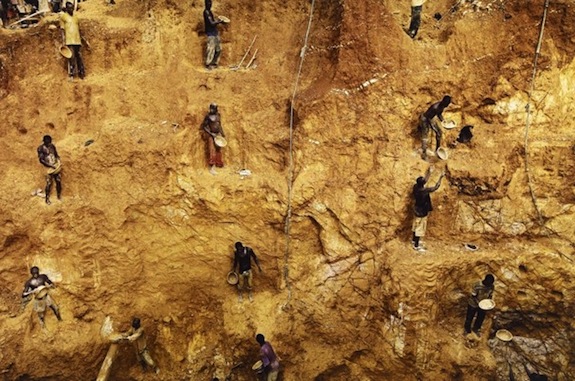VIDEO: Earth Art on the Mall
Four artists left their mark for the Smithsonian’s first ever land art installation as part of a new exhibit about African artists and the earth
![]()
As part of the African Art Museum’s new exhibition opening on Earth Day, “Earth Matters: Land as Material and Metaphor in the Arts of Africa,” the museum invited for the first time ever four artists to take over the Enid A. Haupt Garden. We talked with curator Karen Milbourne about the results, as well as the art on view indoors at the museum.
Discussions of land art usually begins with the renowned American artist Robert Smithson of the 1960s and then skip across the pond to his European counterparts. Milbourne points out that “Africa is remarkably absent from the telling of these histories.” It is a mistake that stands corrected in the new exhibition with more than 40 artists representing 25 of Africa’s 55 nations. Milbourne says, earth as artistic subject and even material is the thread that connects each of the works, but one that is naturally occurring.
Concerns over land rights and environmental degradation appear again and again as well as more personal explorations of the human relationship to place. In selecting the works of art and the artists, Milbourne begins the story roughly around 1807, the year the international slave trade was outlawed, although by no means ended. “After decades of being stolen from one’s land, that was easing,” explains Milbourne. At the same time, colonization and mineral extraction began in earnest, again redefining interactions with the earth. Referencing the many ways Smithsonian experts conceptualize the “earth,” Milbourne divided the show into five parts, “Material Earth,” “Power of the Earth,” “Imagining the Underground,” “Strategies of the Surface” and “Art as Environmental Action.”

“De Money series no. 1″ a 2009 work by Nigerian photographer George Osodi depicts the dangers involved in the search for gold in Obuasi, Ghana. Image courtesy of the African Art Museum
So-called power objects from a Fon artist of Benin made in the early to mid-20th century reveal how the legacy of the slave trade entered into art. Small wooden figures are bound with cords like those used to restrain captives, but in this case, they tie the body to earthen materials, like plants and clay. These power objects were commissioned and placed in the ground to protect their owners. Other works (above) document the dizzying realities of miners, who despite the dangers to their health from mercury exposure and other risks, continue to search for gold.
Finally, pieces like Younès Rahmoun’s Kemmoussa serve as small interventions through what the Moroccan artist calls aesthetic recycling. Taking the many discarded plastic bags that dot the landscape, Rahmoun twists and ties each into rows of tiny knots evoking the beads of a Muslim prayer chain. As with the rest of the works in the show, his work is a striking call to reflection.
“Earth Matters: Land as Material and Metaphor in the Arts of Africa” runs through January 5, 2014 at the African Art Museum.
/https://tf-cmsv2-smithsonianmag-media.s3.amazonaws.com/accounts/headshot/Leah-Binkovitz-240.jpg)
/https://tf-cmsv2-smithsonianmag-media.s3.amazonaws.com/accounts/headshot/Leah-Binkovitz-240.jpg)